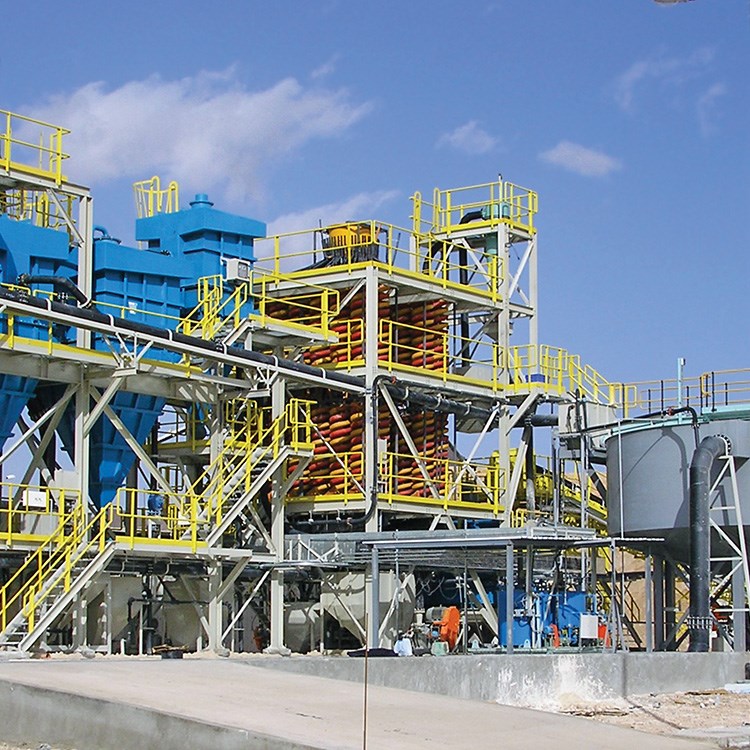Typical applications
- Iron ore
- Chromite
- Mineral sands
- Glass sand
- Gold
- Coal
- Mica
Washwaterless spirals
This type of spiral is used in most applications, particularly for concentrating low-grade ores. The only water required is added with the solids prior to introducing feed onto the spiral. Concentrates are removed either at the bottom directly into the product box or at several intermediate take-off points down the spiral.
Washwater spirals
Washwater spirals require the addition of water at various points down the spiral providing more efficient washing of the concentrate, i.e., transporting away light gangue (silica) from the concentrate band.
Principle of separation
During separation, the slurry enters the spiral through a feed box and then flows on to the spiral surface. As the slurry travels down the spiral, mineral grains settle and sort according to size, shape, and specific gravity.
Spiral separation uses a flowing film principle based on the size and specific gravity difference present in a mineral suite. When fed a dilute pulp mixture of minerals of different specific gravities, the lighter minerals are more readily suspended by the water and attain relatively high tangential velocities so that they climb toward the outer rim of the spiral trough. At the same time, the heavier, non-suspended grains migrate by saltation (non-linear motion that is a combination of rolling and bouncing) along the spiral surface at the lowest portion of the spiral cross section. In a spiral, heavy mineral concentrate is selectively directed into the spiral trough near the inside of the spiral surface through the use of adjustable product splitters. The concentrate then flows through product discharge outlet ports down the length of the helix.
Like most concentrating devices that utilize physical separation principles, the spiral works best on a closely sized feed, though in select cases the unit has some tolerance for wide size ranges. In general, a coarse size limit would be about 1 mm (20 mesh) and a fine limit of approximately 45µm (325 mesh). For best performance, feed should be relatively free of slimes as a high slime content may act like a heavy medium and decrease the effective differences in specific gravity between the minerals to be separated. If slime is in excess of 10% by weight, desliming prior to spiral concentration will almost certainly result in improved spiral performance.
In general, a specific gravity difference of at least 1 is required between light and heavy particles for successful gravity separation.
Feed distributor
A gravity feed slurry distributor, mounted centrally on top of the spiral module, ensures even distribution of feed to each spiral start. The distributor body is constructed of fiberglass and the wetted surfaces are lined with wear resistant polyurethane. The center mixing column and hoses (not shown) are made of durable and replaceable HDPE and the outlet pipes are constructed of polyurethane. Standard distributors are available with up to 48 outlets in either top-fed or bottom-fed configuration. An example of a top-fed 8-way distributor is illustrated in figure above.
Operating parameters
During testing, various parameters can be changed to achieve the desired separation results, keeping in mind that a spiral will normally achieve a 3:1 upgrading ratio (ratio between headfeed grade of heavy minerals and concentrate grade). Therefore, as with most gravity concentrators, a multi-pass flowsheet is often required to achieve the desired grade and recovery of heavy minerals.
Adjustable parameters controlling the separation are:
1. Feed distribution
2. Individual splitter adjustments
3. Feed pulp density
4. Feed rate
5. Wash water rate
Feed distribution
In a plant operation, it is important to maintain a consistent feed rate to the spiral concentrator banks. The variations in feed tonnages to the spirals should not exceed 10%. It is also important to properly distribute the feed to each individual spiral so all spirals within a circuit stage are separating the same.
Proper distribution is normally achieved using a spiral slurry feed distributor. Standard distributors divide the feed into 12, 24, 36 or 48 ways but other sizes are available.
When selecting a distributor one should be chosen which is closest to the number of spiral starts to be operated. The plumbing to each spiral concentrator should be routinely inspected to insure that no plugging or excessive wear has occurred.
Splitter positioning
Efficient concentration depends on proper selection of draw-off ports and the splitter openings used. Heavy minerals such as ilmenite or hematite settle out rapidly in a spiral concentrator and they should be removed as soon as a good wide band forms. Since the concentrate band is wider at the top, splitters near the top of the spiral concentrator should be opened wider than those near the bottom. This means that the splitters collect concentrate at a relatively uniform grade rather than uniform rate.
The product discharge boxes are provided with two heavy-duty splitters for separating into three products, i.e. concentrate, tails and middling. Product boxes are manufactured of solid-cast polyurethane and are designed to collect product from each spiral start.



